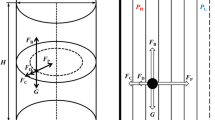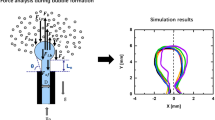Abstract
In order to calculate the collision efficiency factor of bubble and particle (α bp), trajectory analysis is performed. The formulation and equations are adopted from the trajectory analysis developed to calculate the collision efficiency factor in differential sedimentation (α os). The most recently developed hydrodynamic equation and interparticle force based on DLVO theory are included. The effect of each governing parameter is calculated. Although the inclusion of electric repulsion as a function of surface charge of particle and ionic strength of suspension is possible, only hydrodynamic and attraction forces are considered in this research to simulate the case when the bubble-particle system is destabilized. The collision efficiency factor of bubble and particle (α bp) is found to be functions of bubble diameter, particle diameter, Hamaker constant, and particle density. The result ofα bp shows similar trend with publishedα Ds and experimental results.α bp increases as bubble size decreases at constant size ratio, as particle size ratio approaches unity and as Hamaker constant increases. There is only a slight effect of particle density onα bp.
Similar content being viewed by others
References
Han, M.Y., and Lawler, D.F. (1991). “Interactions of Two Settling Spheres: Settling Rates and Collision Efficiencies,Jour. Hydraulic Eng., ASCE, 117, No. 10, 1269–1289.
Han, M.Y. and Lawler, D.F. (1992). “The (Relative) Insignificance of G in Flocculation,Jour. AWWA, 79: No. 10, 79–91.
Jeffrey, D.J. and Onishi, Y. (1984). “Calculation of the Resistance and Mobility Functions for Two Unequal Rigid Spheres in Low Reynolds Number Flow,Jour. Fluid Mech., 139, 261–290.
LaFrance, P. (1994). Masters Thesis, University of Connecticut.
Mally, J.P., Edzwald, J.K. (1991). Concepts for dissolved air flotation treatment of drinking waters.Water SRT-Aqua, 40, No. 1, 7–17.
Okada, K., Akagi, Y., Kogure, M., Yoshioka, N. (1990). Analysis of particle trajectories of small particles in flotation when the particles and bubbles are both charged.Can. J. Chem. Eng., 68, 614–621.
Yao, K.M., Habibian, M.T., O'Melia, C.R. (1971). Water and Wastewater Filtration: Concepts and Applications.Environ. Sci. Technol., 5, No. 11, 1105–1112.
Author information
Authors and Affiliations
Additional information
The manuscript for this paper was submitted for review on October 11, 1997.
Rights and permissions
About this article
Cite this article
Han, M., Dockko, S. & Park, C. Calculation of collision efficiency factor by trajectory analysis in dissolved air flotation. KSCE J Civ Eng 2, 91–95 (1998). https://doi.org/10.1007/BF02830470
Issue Date:
DOI: https://doi.org/10.1007/BF02830470




